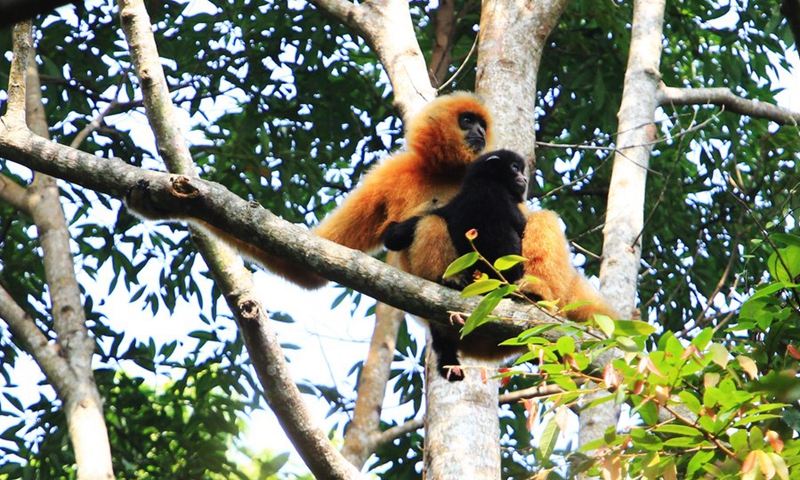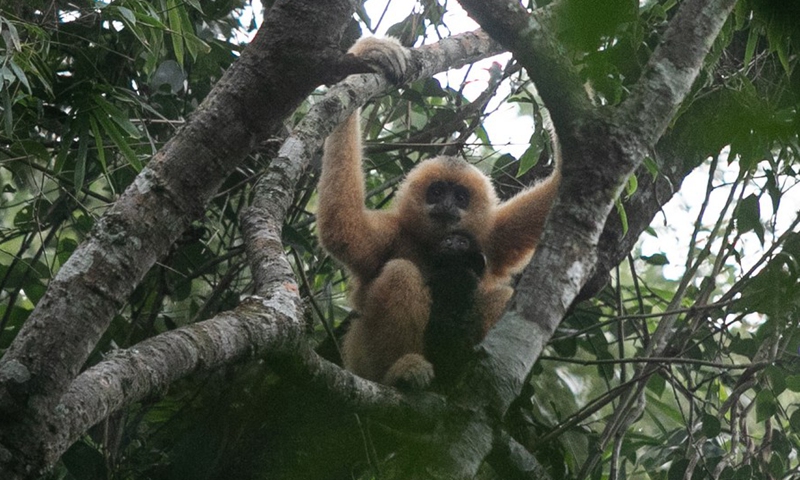
Photo taken on Oct. 28, 2017 shows a female Hainan gibbon and her baby sitting on a tree at the Bawangling National Nature Reserve in Changjiang, south China's Hainan Province.(Photo: Xinhua)

Photo taken on Oct. 25, 2019 shows a Hainan gibbon at the Bawangling nature reserve in south China's Hainan Province. (Photo: Xinhua)
The conservation of Hainan gibbons in China is a success for biodiversity preservation worldwide, the International Union for Conservation of Nature (IUCN) announced on Sunday during the ongoing 7th World Conservation Congress (WCC).
Hainan gibbon, the most endangered of all gibbons and the world's rarest primate, is endemic to the southern Chinese island of Hainan. Its population has increased from as few as 7 to 9 in the 1980s to 35 today, according to a report released at the WCC held both online and in-person in Marseille, France.
The report, titled "The Hainan Gibbon Case Study: Effectively Saving a Critically Endangered Species" and written by 15 experts from 11 organizations worldwide, was released at a press conference simultaneously held in Marseille and Haikou, capital of China's Hainan Province.
The success of this case was achieved "thanks to efficient protection by the Chinese central to local governments and a combined effort by Chinese and international scientists and conservation communities to understand the behavioural ecology of these gibbons," Susan Cheyne, a specialist on small apes with the IUCN Species Survival Commission (SSC), told the press via video link.
Dubbed as "Giant Panda of Hainan," Hainan gibbon is currently found only in a single reserve, the Bawangling Nature Reserve, part of the Hainan Tropical Rainforest National Park.
In March, the monitoring team found that two of the Hainan Gibbon groups each added a baby ape, 7 months old and 6 months old, respectively, said Huang Jincheng, director of the Forestry Department of Hainan Province, at the press conference.
"Continuous monitoring showed that the two baby apes are in good health and grow well," said Huang. "So far, the population of Hainan gibbons has recovered to 5 groups with a total of 35 individuals."
"Hainan gibbon is a very important example of how we can have a conservation success even when a species gets down to a very low level," said Russell Mittermeier, chairman of the IUCN-SSC Primate Specialist Group.
The experiences of this case should be applied to other members of this endangered genres, he added.
Vance Martin, president of the U.S.-based WILD Foundation, told Xinhua after the conference that the case of the Hainan Gibbon is very special because of its extremely low number.
The reason behind this successful conservation is "brilliant and enlightened leadership, international cooperation and experts who really care, and then it is the unique way that the leadership enlisted the local community and the local community who wanted to do it," he said.
Martin, also an expert in international nature conservation and wilderness protection, said there is a big picture story going on in China with nature conservation, "which is a modern-day global example of how you have to go about conservation."
"China's example with eco-civilization, and looking at big picture and putting the big picture to work locally in particular areas with community involvement, is exactly what the world needs to do," he concluded.ഀ匀漀甀爀挀攀唀刀䰀㨀栀琀琀瀀㨀⼀⼀眀眀眀⸀渀攀眀猀⸀挀渀⼀攀渀最氀椀猀栀⼀㈀ ㈀ⴀ 㤀⼀ 㔀⼀挀开㌀ 㘀㤀㜀㈀⸀栀琀洀ഀ㰀栀琀洀氀㸀ഀ㰀戀漀搀礀㸀ഀ㰀℀ⴀⴀ匀琀愀爀琀䘀爀愀最洀攀渀琀ⴀⴀ㸀㰀栀 挀氀愀猀猀㴀∀䈀琀椀琀氀攀∀ 猀琀礀氀攀㴀∀昀漀渀琀ⴀ昀愀洀椀氀礀㨀 䜀攀漀爀最椀愀㬀 洀愀爀最椀渀㨀 瀀砀㬀 瀀愀搀搀椀渀最㨀 瀀砀㬀 昀漀渀琀ⴀ猀椀稀攀㨀 ㌀㐀瀀砀㬀 氀椀渀攀ⴀ栀攀椀最栀琀㨀 㐀㈀瀀砀㬀 昀漀渀琀ⴀ眀攀椀最栀琀㨀 渀漀爀洀愀氀㬀 挀漀氀漀爀㨀 爀最戀⠀ Ⰰ Ⰰ ⤀㬀 昀漀渀琀ⴀ猀琀礀氀攀㨀 渀漀爀洀愀氀㬀 昀
